
In the United States, female fisticuffs were marginalized, first
In the United States, female fisticuffs were marginalized, first as erotic vaudeville in the 19th century and later as serious competition developed in the first half of the 20th. Legal wars waged by boxers in the 1960s and '70s won women the right to compete professionally nationwide.






The words of Katherine Dunn, “In the United States, female fisticuffs were marginalized, first as erotic vaudeville in the 19th century and later as serious competition developed in the first half of the 20th. Legal wars waged by boxers in the 1960s and '70s won women the right to compete professionally nationwide,” resound with the strength of history reclaimed. In this reflection, Dunn, both novelist and boxing historian, reminds us that the struggle of women in the ring is not merely a tale of sport, but a chronicle of perseverance, dignity, and the eternal fight for recognition. Her words are the story of how women transformed the spectacle of mockery into the theater of courage — how they turned from being ornaments of entertainment into warriors of purpose. It is not only a history of boxing, but of womanhood itself, battling its way from the margins toward the center of respect.
The origin of this quote lies in the long and winding road of women’s boxing, a discipline both ancient and forbidden. In the 19th century, when society deemed women delicate and domestic, their appearances in the ring were treated not as displays of strength, but of scandal. Vaudeville, that stage of laughter and desire, turned their struggles into curiosities, stripping the fight of honor and filling it instead with voyeurism. The blows they exchanged were not judged as skill, but as seduction. Dunn’s mention of “erotic vaudeville” reveals how the female body — strong, resilient, and capable — was denied its dignity, reduced to spectacle rather than celebrated as symbol. In that era, a woman’s punch was an act not of sport but of rebellion, her very stance in the ring a declaration against a culture that believed grace and power could not coexist within the same soul.
But as the 20th century dawned, a new generation of women rose, unafraid to sweat, to bleed, and to shatter expectation. They fought in backrooms and barns, under false names and against the grain of law. In their determination, female boxers became the embodiment of discipline, patience, and defiance. By mid-century, what had begun as parody evolved into craft, and by the 1960s and '70s, the fight moved beyond the ring and into the courts. Here, Dunn speaks of the “legal wars” — battles not fought with gloves, but with petitions and protests, waged by women who refused to be silenced or sidelined. They demanded not privilege, but equality; not pity, but permission to prove themselves on the same stage as men. Through lawsuits, advocacy, and unyielding persistence, they broke the legal barriers that kept them from professional competition.
Among those warriors was Cathy Davis, who in 1977 became the first woman officially licensed as a professional boxer in the United States after suing the New York State Athletic Commission. Her victory was not merely personal — it was a blow struck for every woman who had ever been told to sit down instead of stand up. In her success, the old taboo began to crumble. But it came at a price, for each woman who stepped into the ring carried not only the weight of her opponent but the burden of centuries of disbelief. Their triumphs were slow and hard-won, often ridiculed or dismissed. Yet, as Dunn reminds us, these were the fights that reshaped the boundaries of both sport and society, proving that courage knows no gender.
In the spirit of the ancients, these women can be likened to the Spartan mothers, who told their sons to return from battle “with your shield or on it.” But here, it was the daughters who entered the fray, armed not with sword or spear, but with fists and faith. They defied the walls built around them — social, moral, and legal — and in doing so, they expanded the very definition of what it meant to be a warrior. The same spirit that once drove Artemisia of Caria to command ships in battle, or Joan of Arc to lift her sword against injustice, now lived in women who wrapped their hands in gauze and leather and dared to claim their rightful place under the lights of the ring.
The power of Dunn’s insight lies in her recognition that every act of resistance, however small, ripples through time. The blows these women took and the trials they endured were not just for their own glory, but for the generations yet unborn. Today, when young women step into arenas — whether athletic, academic, or political — they walk on the ground these fighters made solid with their struggle. Dunn’s words call us to remember that progress is rarely gentle; it is forged in conflict, through those willing to fight when the world tells them not to.
And so, the lesson endures: true equality is not granted — it is fought for. Each generation must pick up its own gloves, must challenge the invisible rules that still divide and diminish. The path to dignity may begin in derision, but it ends in respect for those who refuse to yield. As Katherine Dunn reminds us, history’s margins are not prisons — they are training grounds for the brave. Let all who read her words carry this truth: that strength, whether in the ring or in life, is not measured by muscle or victory, but by the courage to stand where others say you do not belong — and to keep fighting until you do.






AAdministratorAdministrator
Welcome, honored guests. Please leave a comment, we will respond soon